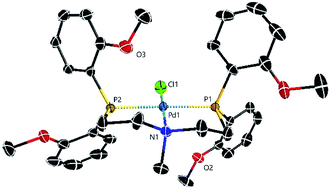Performance of enhanced DuBois type water reduction catalysts (WRC) in artificial photosynthesis – effects of various proton relays during catalysis†
Abstract
Inspired by natural photosynthesis, features such as proton relays have been integrated into water reduction catalysts (WRC) for effective production of hydrogen. Research by DuBois et al. showed the crucial influence of these relays, largely in the form of pendant amine functions. In this work catalysts are presented containing innovative diphosphinoamine ligands: [M(II)Cl2(PNP-C1)], [M(II)(MeCN)2(PNP-C1)]2+, [M(II)(PNP-C1)2]2+, and [M(II)Cl(PNP-C2)]+ (M = Pt2+, Pd2+, Ni2+, Co2+; PNP-C1 = N,N-bis{(di(2-methoxyphenyl)phosphino)methyl}-N-alkylamine, PNP-C2 = N,N-bis{(di(2-methoxyphenyl)phosphino)ethyl}-N-alkylamine and alkyl = Me, Et, iso-Pr, Bz). Synthetic strategies and detailed characterisation are covered, including 1H-, 13C-, and 31P-NMR analysis, mass spectroscopy and single crystal X-ray diffractometry (XRD). The catalytic properties have been explored by changing the pendant amines and auxiliary methoxy coordination sites, as well as enlarging the ligand backbone. Moreover, confirmed by density functional theory (DFT) calculations based on XRD data in vacuo and solvent environment, two very different catalytic cycles are proposed. PNP-C1 shows a classical proton relay, whereas PNP-C2 allows an additional coordination of nitrogen, acting optionally like a pincer. Through new insights into efficiency and stability-increasing influences of proton relays in general, their number per metal centre, an enlarged ligand backbone and the use of solvato instead of halogenido complexes, substantial improvements have been made in catalytic performance over the DuBois et al. catalysts and recently self-made WRCs. The turnover number (TON) related to the single site of cost-efficient nickel WRCs is increased from 11.4 to 637, whereas a corresponding palladium catalyst gives TON as high as 2289.

- This article is part of the themed collection: Artificial photosynthesis


 Please wait while we load your content...
Please wait while we load your content...